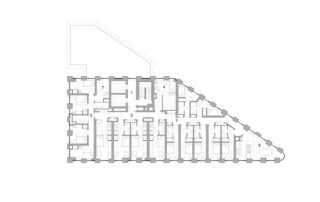Glenn Howells’ Architects’ 32-storey, brick-clad student tower for Urbanest in London’s Vauxhall
Standing among a cluster of emerging towers as part of the Vauxhall Square development, Glenn Howells Architects’ £40m Urbanest Vauxhall is a 32-storey student housing scheme with 454 bedrooms in a range of studios and clusters.
The plan derives from the site’s restricted footprint, creating a striking bullnose apex facing towards the new US Embassy at Nine Elms. Currently the tallest brick-clad building in the UK, it’s facades refer to the industrial context and railway viaduct arches.
Curved panes of glass on the bullnose and the rigorous order of the masonry facade consciously evoke New York’s prototypical Flatiron building of 1902. The vertical proportions are ‘stretched’ at the base and top while the mid floors express each storey. An annexe contains the entrance foyer, a cycle store and a study/lounge area while the building is crowned by a rooftop lounge and terrace with spectacular views across the borough.
The accommodation – standardised on each floor to achieve the economies of vertically stacked services and structure – includes self-contained studios and clusters of rooms with either en-suite or shared bathrooms and kitchen/living areas, as well as wheelchair-accessible rooms. Lightweight, prefabricated panels of brick slips are mechanically fixed to a metal sub-frame which forms part of the module comprising full-height fixed glazing and a perforated metal screen.
The project is the first brick-clad building over 90 metres tall in the UK and innovative methods of design and construction were developed to deliver the project on its constrained site. With only space for a single tower crane, and to meet the tight programme, the facade, services and interior installation would have to be carried out simultaneously. The crane was needed for internal concrete works, and therefore not available to install the facade panels, so these were redesigned to be lifted by a smaller floor-mounted hoist. Weighing more than five tonnes, the intended precast concrete panels with punch windows would have been too heavy, so the team reengineered them as a lightweight panel system using an aluminium unitised curtain walling system with brickwork piers attached separately. As well as being sufficiently light for lifting, the new aluminium unitised curtain-walling system offered rapid watertightness.
The system utilised a mechanically-fixed steel backing sheet which gave a robust anchorage for the bricks. The usual method of installing the system was to bring the individual sheets of brick slips to site and assemble them as piers, but this would have required the joints between interlocking corner bricks to be mortared on site by hand – potentially resulting in an inconsistent finish and increased on-site labour requirements. The team therefore developed the system to integrate the brick slips as complete piers in the factory, which were then delivered to site, lifted and placed as finished components. The redeveloped solution meant that there were only horizontal joints between panels, which minimised on-site work and helped improve construction speed and quality. Due to the high proportion of prefabrication the architect says “the build quality was exceptional, with limited onsite snagging. The only defects were caused by damage in transit and the design allowed for any damaged panels to be easily replaced after installation”.
Additional Images
Credits
Architect
Glenn Howells Architects
Client
Urbanest
Project manager
Tower8
Quantity surveyor
Cast
Contractor
Balfour Beatty
Interiors
Michaelis Boyd
Structural engineer
Walsh
M&E engineer
Swiftline
Fire engineer
Trenton Fire
Planning consultant
Gerald Eve
Facade consultant
Fill Metallbau































